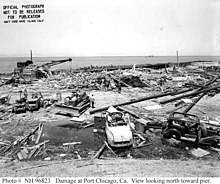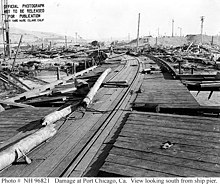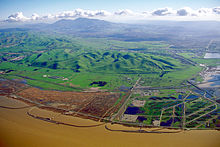Port Chicago Disaster
| Port Chicago Naval Magazine National Memorial | ||
|---|---|---|
| memorial | ||
|
|
||
| Location: | California , United States | |
| Next city: | Concord | |
| Surface: | 2023 m² | |
| Founding: | October 28, 1992 | |
The Port Chicago Disaster was a major explosion that occurred in the Port Chicago Naval Magazine near Concord , California , in the United States on July 17, 1944 . When ammunition was being loaded onto cargo ships , it exploded, killing 320 sailors and civilians. 400 other people were injured. Most of the victims were Americans of African descent because the dangerous work was carried out exclusively by blacks under the orders of white officers and under poor security. The site of the explosion has been designated as a National Memorial since 1992 and has special significance for the history of racial segregation .
background
The military port of Port Chicago was on the south side of Suisun Bay in the confluence of the Sacramento Rivers and the San Joaquin Rivers . Suisun Bay is connected to the Pacific Ocean by San Francisco Bay . The port itself consisted of three piers, which were built into the marshland zone. He was assigned a United States Navy ammunition depot , the Port Chicago Naval Magazine , on firm ground about 1.5 km away . From there, railroad tracks led to a loading zone at the port, where individual railroad cars could be unloaded behind explosion protection walls . The port and depot were named after the nearby town of Port Chicago . The magazine was established shortly after the attack on Pearl Harbor as a branch of the Mare Island Naval Shipyard, which had existed on the north side of Saisun Bay since 1857 , and was an important replenishment base for the United States for the Pacific War .
Ammunition for the American troops in the Pacific was delivered here by the railroad and transferred to ships . The loading activities were carried out exclusively by African-Americans under the command of white officers. Around 150,000 blacks were in the service of the Navy, but they were only allowed to carry out camp and auxiliary activities and were denied access to combat units. The grenades , bombs and torpedoes were loaded without any special security measures, the officers held unofficial competitions between their three working groups, which could carry out the loading work the fastest.
The base was later renamed Concord Naval Weapons Station , became the responsibility of the United States Army in 1999 and is now called Military Ocean Terminal Concord . Today freighters and maritime prepositioning ships are loaded with weapons and ammunition there, not warships. Port Chicago was dissolved in 1968 to expand the security zone of the depot.
The catastrophe
On the evening of July 17, 1944, the merchant ship SS EA Bryan , a Liberty freighter , loaded with around 5,000 tons of ammunition, and the still empty Quinalt Victory , one of the new Victory ships , lay at the loading dock of the Navy depot. Another 450 tons of ammunition in 16 freight cars were waiting on the pier . A first explosion occurred at 10:18 p.m. and started a fire . Six seconds later, the entire charge of the SS EA Bryan exploded . An investigation by the US Navy into the cause of the accident remained without concrete result due to the destruction. It is believed that a mistake in the loading of torpedoes triggered the accident, since the loading happened under great time pressure. The explosion destroyed the pier and large parts of the naval base and the small settlement of Port Chicago, after which the base was named. The explosion was so violent that it was felt throughout the greater San Francisco area and as far as Boulder City , Nevada, half a mile away .
320 sailors were killed and 400 injured. 202 African-Americans were among the victims. More people were injured from flying debris and broken windows. The houses in Port Chicago were largely destroyed, but there were no deaths there.
The Port Chicago Mutiny
After the fires were put out, African-American sailors were once again tasked with recovering the victims, who were scattered around the area. After the rescue work was completed, less than a month later, the sailors of the rescue team received the order to resume loading activities. On August 9, 1944, three weeks after the disaster, 258 of a total of 320 sailors in the loading battalion refused to continue the dangerous work. They wanted to draw attention to the racism in the Navy, its disastrous working conditions and the unequal treatment of blacks and whites in the Navy. The case went to court martial . It consisted of seven white Navy officers , a judge, and six jurors.
208 of the 258 agreed to resume work. They continued their service and received a negative certificate when they were released. The remainder became known as Port Chicago 50 . They were not charged with simply refusing to give orders, but with mutiny with the intention of taking command of their unit. At the end of the trial, they were found guilty, dishonorably discharged from the Navy, and sentenced to between 8 and 15 years in prison. This is the only case in the history of the US Navy in which a full court martial for mutiny was carried out. Thurgood Marshall , then a lawyer for the National Association for the Advancement of Colored People and later a judge of the US Supreme Court , attended the trial as an observer and spoke out publicly against the actions of the Navy judiciary. Finally, after the end of the war in 1946, he got the 50 sailors suspended.
In June 1945, before the war in the Pacific ended, the Navy began to partially desegregate it. In July 1948, President Harry Truman issued an executive order ending all racial segregation in all units of the armed forces. The protests following the trials of the Port Chicago mutiny are seen as an important contribution to this.
Under the influence of the civil rights movement , multiple reviews of the disaster, the working conditions and the process began in the 1960s. The investigation revealed that the charges were unjustified. The actions of the sailors were at most to be classified as a simple refusal to give orders and the penalty was completely excessive. However, it was no longer possible to resume the process for formal reasons. In 1999, following political campaigns, President Bill Clinton pardoned former sailor Freddie Meeks, one of three convicts who were still alive at the time.
The National Memorial , administered by the National Park Service , was dedicated by the United States Congress in 1992 . Due to security concerns about a memorial inside an active military facility, it was not until 1994 that the memorial could be inaugurated. It is located on the wharf of the Military Ocean Terminal Concord. The memorial is only accessible to US nationals and permanent residents with pre-booked tours and a security clearance.
On October 28, 2009, the memorial was upgraded to the official unit of the National Park Service . The Citizens' Initiative Port Chicago Committee is committed to expanding the existing memorial to around 1 km² of the former port area of Port Chicago. The site of the memorial could contain former railroad facilities and some freight cars from the 1940s. The neighboring chapel of the base, which shows lead-glass windows with pictures from the Second World War , would be a possible addition.
The misfortune in the media
- The story of the Port Chicago 50 is told in the film Mutiny , which received an Emmy in 1999 . The film is directed by Kevin Hooks .
- In the American series JAG - On behalf of the honor , the incident in episode 154 Port Chicago was also discussed.
See also
literature
- Robert L. Allen: The Port Chicago Mutiny . Heyday Books, Berkeley, CA 2006, ISBN 978-1-59714-028-7 .
Web links
- US Navy: Naval History and Heritage Command - Port Chicago Naval Magazine Explosion, 1944 (English, with links to online documents)
- US Maritime Service Veterans memorial page
- National Park Service: Port Chicago Naval Magazine National Monument (official site; English)
- The Port Chicago Disaster: A Resource for Students and Teachers ( Memento from May 6, 2010 on the Internet Archive )
- The Port Chicago 50: An Oral History by Dan Collison
Individual evidence
- ↑ globalsecurity.org: Naval Weapons Station Port Chicago Naval Magazine, Concord, California
- ↑ Contra Costa County Office of Education: The Port Chicago Desaster - The explosion ( Memento from December 2, 2009 in the Internet Archive )
- ^ Contra Costa County Office of Education: The Port Chicago Desaster - The Court Martial ( Memento from January 1, 2010 in the Internet Archive )






